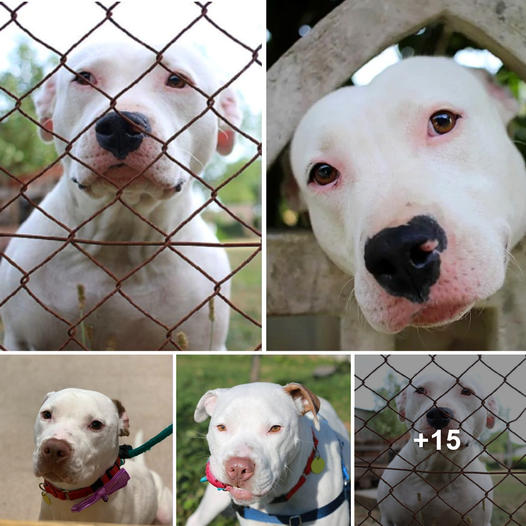
Camila the chocolate Labrador grew up in the company of some of the fiercest wild beasts in Mexico’s “The Black Jaguar-White Tiger Foundation” sanctuary. However, her inseparable bond with Miki the white lion is one of a kind! Despite their striking differences, Miki and Camila are two peas in a pod who devotedly stick together through thick and thin.

This video captures one of the rare instances when Camila and Miki have a minor falling-out during their playtime. Owing to his inherently feisty temperament, Miki is the first one to stomp off the scene. But Camila patiently lingers by the enclosure and waits for her silly buddy to calm down.

As expected, Miki feels bad about being mean and soon returns to his tail-wagging doggie friend with a sorry look on his face. The beautiful lion adorably hangs his head in remorse as he comes closer to Camila and gently grabs her paw. In an endearing gesture to seek forgiveness, he kisses her paw and begs her to forget their petty squabble. Aww!

Being loyal to a fault, Camila is obviously not one to hold grudges. It’s all water under the bridge for her as she brushes aside the issue and engages the still-sulking Miki in a game of chase. The affection between these contrastingly unconventional friends is baffling on so many levels!
Click the video below to watch Miki and Camila’s unconventional love shining through in their little apology encounter!
Please ‘SHARE’ to pass on this story to a friend or family member
What five characteristics do all animals have in common?
What five characteristics do all animals have in common?
In the following slides, we’ll explore the basic characteristics shared by all (or at least most) animals, from snails and zebras to mongooses and sea anemones: multicellularity, eukaryotic cell structure, specialized tissues, sexual reproduction, a blastula stage of development, motility, heterotrophy and possession …
What characteristics do all animals have in common quizlet?
The six characteristics that all organisms in the animal kingdom share are: they are multicellular, almost all can move, their cells have no cell wall, they have to hunt for their own food (consumers), they are eukaryotic, reproduce sexually-when two cells join to form off spring and their cells lack chloroplasts.
What 4 characteristics do all animals share?
Most animals share these characteristics: sensory organs, movement, and internal digestion. All of them are illustrated in Figure below. Animals can detect environmental stimuli, such as light, sound, and touch. Stimuli are detected by sensory nerve cells.
What are the 7 characteristics of all animals?
These are the seven characteristics of living organisms.
1 Nutrition. Living things take in materials from their surroundings that they use for growth or to provide energy.
2 Respiration.
3 Movement.
4 Excretion.
5 Growth.
6 Reproduction.
7 Sensitivity.
What are the 6 characteristics common to all animals?
They are as follows:
All animals are made up of cells that do not have cell walls.
All animals are multicellular organisms.
Most animals reproduce sexually.
All animals are capable of self-propelled motion at some point in their lives.
All animals are heterotrophic and must consume other organisms for energy.
What protein do all animals have in common?
The exctracellular protein collagen (making the most abundant extracellular protein in animals) which is required in multicellular organisms to keep the cells together, which is exclusive to animals. Most enzymes responsible for metabolic pathways.
What are the 3 characteristics of animals?
Characteristics of Animals
Animals are multicellular organisms.
Animals are eukaryotic.
Animals are heterotrophic.
Animals are generally motile.
Animals possess specialized sensory organs such as eyes, ears, nose, skin, and tongue.
Animals reproduce sexually.
What are the basic characteristics of all animals?
In the following slides, we’ll explore the basic characteristics shared by all (or at least most) animals, from snails and zebras to mongooses and sea anemones: multicellularity, eukaryotic cell structure, specialized tissues, sexual reproduction, a blastula stage of development, motility, heterotrophy and possession of an advanced nervous system.
What do all animals have in common with each other?
Sexual reproduction is another characteristic shared by most, but not all, animals. Regardless of species, all animals share multicellularity, which means their bodies consist of multiple cells. This sets animals apart from organisms, such as single-celled algae, fungi, bacteria and other basic life forms.
What do plants and animals have in common?
Most plants are also multicellular, so although this is a characteristic shared by all animals, it is not one unique to animals.Every animal on the planet is a eukaryote. A eukaryote is an organism that consists of cells that have membrane-bound nuclei and organelles.
What are the characteristics of the animal kingdom?
All animals are eukaryotic, multicellular organisms, and most animals have complex tissue structure with differentiated and specialized tissue. Animals are heterotrophs; they must consume living or dead organisms since they cannot synthesize their own food and can be carnivores, herbivores, omnivores, or parasites.





